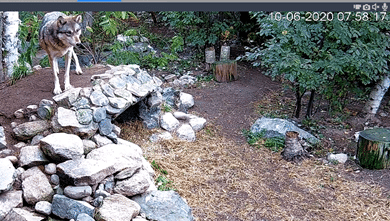6 October 2020
Boltz is feeling better today than he did over the weekend. His hind quarter mobility and stability continues to be the main symptom as we try to narrow down the influences of various treatments. He is alert, behaviorally interactive and defending ravens from his deer leg. Other than responding to some external stresses that can be part of life on a public exhibit (vehicles, traffic, noise from garbage trucks etc.), he generally rests on or in the den or in the straw beds adjacent to the building. His resting patterns are pretty consistently defined as long periods of rest. This is good for his overall well-being and may contribute to healing. We also believe that his ability to rest comfortably is a good indication that the condition is not painful. It’s been our experience with pain issues (including Grizzer’s ACL issue), that there is a lot of repositioning to find the appropriate pain-free position. When Boltz rests, he curls up in the hay and falls asleep. As you may imagine, all of the events over the last month can impact a wolf’s trust. In an effort to help improve that trust, today during wolf care, he welcomed a trail of Venison Cakes as a treat and a motivator to get him comfortable with coming into more confined spaces and take treats from the staff. We are planning for the next set of medical tests that will require an immobilization. This time, it will be much smoother thanks to the move into the Pack Holding Area that is adjacent to the Wolf Care Center. Because we used Glucocorticoids (e.g., dexamethasone, methylprednisolone, prednisone) in treatment, we need to wait for a bit of time before doing the next tests. Glucocorticoids are known to increase the white blood cell (WBC) count and this is one of the key components needed to assess infection or the potential for other conditions. I am using the surveillance images with the date and time stamp so we can track his posture, alertness and overall condition on a daily basis.




